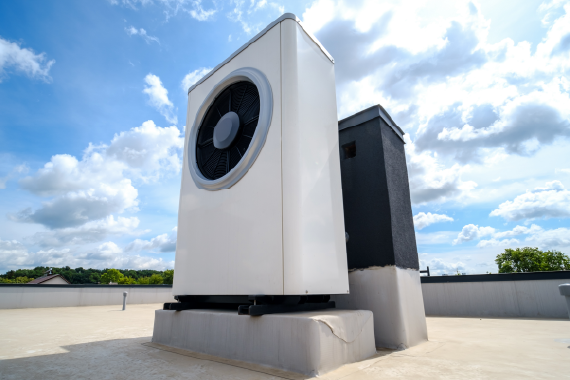We collaborate to achieve sustainable success
Get in touch with usRetrofit or Replace? Strategic Decisions for Businesses in the Evolving F-Gas Landscape
As the F-Gas phase-down accelerates through mid-2025, businesses across industries are confronting a critical strategic dilemma: what to do with their existing heating, ventilation, air conditioning, and refrigeration (HVACR) infrastructure. With stringent new regulations taking hold and the supply of traditional high-Global Warming Potential (GWP) refrigerants dwindling, the question of whether to retrofit older systems or invest in entirely new, compliant equipment has become paramount. This decision carries significant operational, financial, and environmental implications, demanding careful consideration and proactive planning.
The Looming Challenge for Legacy Systems
The core of the challenge lies in the aggressive phase-down of hydrofluorocarbons (HFCs), driven by regulations like the EU F-Gas Regulation (EU 2024/573) and the U.S. EPA's AIM Act. From January 2025, the EU has capped HFC production rights at just 60% of 2011-2013 baseline volumes, drastically reducing the availability of virgin HFCs. Similarly, new air conditioning units in the U.S. must now use refrigerants with a GWP of 700 or less, effectively phasing out common refrigerants like R-410A in new installations.
While these regulations primarily target new equipment and the overall supply of refrigerants, they have a direct impact on existing systems. Older units that rely on high-GWP refrigerants like R-410A or R-404A are not immediately banned, but their maintenance and repair costs are set to skyrocket due to diminishing supply and increasing prices of these substances. If a leak occurs, recharging an older system could become prohibitively expensive or even impossible due to scarcity. This economic pressure, coupled with the risk of equipment failure and operational downtime, compels businesses to act.
Option 1: The Retrofit Pathway
For many businesses, retrofitting existing HVACR systems presents an attractive option, particularly for those with newer equipment or tighter budgets. Retrofitting involves modifying an existing system to enable it to operate with a lower-GWP refrigerant.
What it involves: This can range from relatively minor component replacements, such as updating compressors, coils, and valves, to more extensive modifications. For instance, coils might need factory-installed R-454B TXVs and refrigerant detection system sensors, along with updated electrical components to minimize ignition sources for mildly flammable (A2L) refrigerants. Companies like Aggreko are actively retrofitting a significant portion of their own fleets and assisting clients in adapting their equipment to comply with F-Gas regulations, often by transitioning to natural refrigerants like CO₂
Advantages:
- Potentially Lower Upfront Cost: Retrofitting can often be less expensive than a complete system replacement, making it a viable solution for businesses on tight budgets.
- Extends Asset Life: It allows businesses to maximize the lifespan of their existing capital investments, delaying the need for full replacement.
- Faster Implementation: In some cases, retrofitting can be quicker than a full installation, minimizing operational disruption.
Challenges:
- Compatibility Issues: Not all older systems are compatible with new refrigerants, and retrofitting can be costly and impractical for very old units.
- Technical Complexity: It requires specialized technical expertise and tools, as new refrigerants may have different thermodynamic properties and safety considerations, such as mild flammability.
- Training Requirements: Technicians need updated training and certification to handle these new refrigerants safely and effectively.
- Limited Long-Term Scope: While extending life, retrofitted systems may not achieve the same energy efficiency or long-term compliance as purpose-built new systems.
Option 2: The Full Replacement Strategy
For businesses seeking a long-term, future-proof solution, a complete system replacement is often the preferred route. This involves decommissioning old equipment and installing new, compliant HVACR systems.
What it involves: This strategy entails investing in new units designed from the ground up to operate with low-GWP refrigerants like R-32 or R-454B, and to meet stricter energy efficiency standards. Manufacturers are designing these systems to consume less energy while providing effective cooling and heating.
Advantages:
- Long-Term Compliance: New systems are built to meet current and future regulatory requirements, ensuring adherence for years to come.
- Improved Energy Efficiency: Modern systems are significantly more energy-efficient, leading to lower utility bills and reduced operational costs over their lifespan.
- Enhanced Performance and Reliability: New equipment often offers superior performance, advanced features, and greater reliability compared to older, retrofitted units.
- Reduced Environmental Footprint: By utilizing ultra-low GWP refrigerants and consuming less energy, new systems significantly reduce a business's carbon footprint.
Disadvantages:
- Higher Initial Capital Expenditure (CAPEX): The upfront cost of replacing an entire system can be substantial.
- Installation Complexity: While designed for new refrigerants, installation still requires skilled professionals and may involve some disruption.
Making the Decision: A Strategic Framework
The "retrofit vs. replace" decision is not one-size-fits-all. Businesses should conduct a thorough assessment, considering several key factors:
- Age and Condition of Existing Equipment: Older systems nearing the end of their operational life are often better candidates for full replacement, as retrofitting may not be cost-effective or practical.
- Budget and Financial Strategy: Evaluate the upfront costs of both options against long-term operational savings and potential tax credits or incentives for energy-efficient upgrades.
- Operational Needs and Criticality: For mission-critical cooling systems where downtime is unacceptable, investing in new, highly reliable equipment might be prioritized.
- Long-Term Sustainability Goals: Businesses with ambitious environmental targets may opt for full replacement to maximize GWP reduction and energy efficiency benefits.
- Expert Consultation: Partnering with HVACR professionals can provide invaluable guidance. They can conduct refrigerant audits, assess system viability, and help plan a timeline for transition.
The F-Gas phase-down in mid-2025 presents a clear fork in the road for businesses managing cooling and heating infrastructure. Whether opting for a strategic retrofit or a complete system overhaul, proactive planning is paramount. The rising costs and diminishing availability of traditional refrigerants mean that inaction is no longer a viable strategy. By carefully weighing the advantages and disadvantages of each path, and leveraging expert advice, businesses can make informed decisions that ensure compliance, optimize operational efficiency, and contribute to a more sustainable future.

